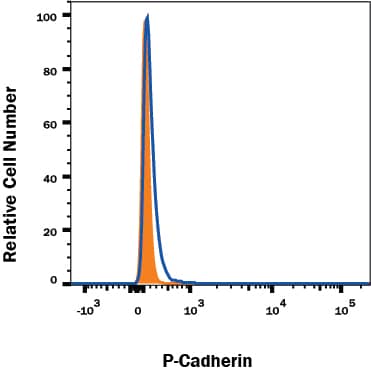Human P-Cadherin PerCP-conjugated Antibody Summary
Asp108-Gly654
Accession # CAA45177
Applications
Please Note: Optimal dilutions should be determined by each laboratory for each application. General Protocols are available in the Technical Information section on our website.
Scientific Data
 View Larger
View Larger
Detection of P‑Cadherin in A431 Human Cell Line by Flow Cytometry. A431 human epithelial carcinoma cell line was stained with Mouse Anti-Human P-Cadherin PerCP-conjugated Monoclonal Antibody (Catalog # FAB861C, filled histogram) or isotype control antibody (Catalog # IC002C, open histogram). View our protocol for Staining Membrane-associated Proteins.
 View Larger
View Larger
P-Cadherin Specificity is Shown by Flow Cytometry in Knockout Cell Line. P-Cadherin knockout A431 human epithelial carcinoma cell line was stained with PerCP-conjugated Mouse Anti-Human P-Cadherin Monoclonal Antibody (Catalog # FAB861C, filled histogram) or isotype control antibody (Catalog # IC002C, open histogram). No staining in the P-Cadherin knockout A431 cell line was observed. Cells were stained in a buffer containing Ca2+ and Mg2+. View our protocol for Staining Membrane-associated Proteins.
Reconstitution Calculator
Preparation and Storage
- 12 months from date of receipt, 2 to 8 °C as supplied.
Background: P-Cadherin
Placental (P) - Cadherin (PCAD) is a member of the Cadherin family of cell adhesion molecules. Cadherins are calcium-dependent transmembrane proteins, which bind to one another in a homophilic manner. On their cytoplasmic side, they associate with the three catenins, alpha, beta, and gamma (plakoglobin). This association links the cadherin protein to the cytoskeleton. Without association with the catenins, the cadherins are non-adhesive. Cadherins play a role in development, specifically in tissue formation. They may also help to maintain tissue architecture in the adult. P-Cadherin is a classical cadherin molecule. Classical cadherins consist of a large extracellular domain which contains DXD and DXNDN repeats responsible for mediating calcium-dependent adhesion, a single-pass transmembrane domain, and a short carboxy-terminal cytoplasmic domain responsible for interacting with the catenins. Human P-Cadherin is an 829 amino acid (aa) protein with a 26 aa signal sequence and an 803 aa propeptide. The mature protein begins at aa 108 and has a 548 aa extracellular region, a 23 aa transmembrane region, and a 151 aa cytoplasmic region. The human and mouse mature PCAD proteins share 87% homology.
- Shimoyama, Y. et al. (1989) J. Cell Biol. 109:1787.
- Bussemakers, M.J.G. et al. (1993) Mol. Biol. Reports 17:123.
- Overduin, M. et al. (1995) Science 267:386.
- Takeichi, M. (1991) Science 251:1451.
- Nose, A. et al. (1987) EMBO J. 6:3655.
Product Datasheets
FAQs
No product specific FAQs exist for this product, however you may
View all Antibody FAQsReviews for Human P-Cadherin PerCP-conjugated Antibody
There are currently no reviews for this product. Be the first to review Human P-Cadherin PerCP-conjugated Antibody and earn rewards!
Have you used Human P-Cadherin PerCP-conjugated Antibody?
Submit a review and receive an Amazon gift card.
$25/€18/£15/$25CAN/¥75 Yuan/¥2500 Yen for a review with an image
$10/€7/£6/$10 CAD/¥70 Yuan/¥1110 Yen for a review without an image

